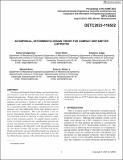| dc.contributor.author | Ghodgaonkar, Aditya | |
| dc.contributor.author | Welsh, Emily | |
| dc.contributor.author | Judge, Benjamin | |
| dc.contributor.author | Bono, Michael | |
| dc.contributor.author | Winter, Amos G | |
| dc.date.accessioned | 2024-05-10T13:40:48Z | |
| dc.date.available | 2024-05-10T13:40:48Z | |
| dc.date.issued | 2023-08-20 | |
| dc.identifier.uri | https://hdl.handle.net/1721.1/154895 | |
| dc.description.abstract | Growing food demand, climate change, and constrained natural resources create the need for large-scale, sustainable agricultural intensification. Despite drip irrigation’s ability to be more water efficient than traditional irrigation technologies, its adoption and retention is limited to due to its high hydraulic equipment costs, particularly in low/middle-income countries. As a commodity product, drip emitters contribute directly to raw material costs and additionally dictate tube thickness and related material consumption. This work introduces a new empirical, deterministic design theory for creating compact, low-cost labyrinths, which are otherwise a volume-intensive component of drip irrigation emitters. To simplify design analysis a review of current commercial art, manufacturing process constraints and symmetry-based geometric relationships was conducted, resulting in the labyrinth’s tooth tip gap being selected as a key design variable. The tip gap is correlated with the hydraulic performance of a test labyrinth geometry via a Design of Experiments approach. The experiments shed light on two distinct fluid dynamic regimes in the labyrinth based on the tip gap size and provide an empirical expression between the two. This work demonstrates that simultaneous consideration of symmetry, manufacturing process and design goals enables rapid synthesis of labyrinths that are 43.77% shorter than comparable commercial designs. | en_US |
| dc.language.iso | en | |
| dc.publisher | American Society of Mechanical Engineers | en_US |
| dc.relation.isversionof | 10.1115/detc2023-116552 | en_US |
| dc.rights | Article is made available in accordance with the publisher's policy and may be subject to US copyright law. Please refer to the publisher's site for terms of use. | en_US |
| dc.source | ASME | en_US |
| dc.title | An Empirical, Deterministic Design Theory for Compact Drip Emitter Labyrinths | en_US |
| dc.type | Article | en_US |
| dc.identifier.citation | Ghodgaonkar, Aditya, Welsh, Emily, Judge, Benjamin, Bono, Michael and Winter, Amos G. 2023. "An Empirical, Deterministic Design Theory for Compact Drip Emitter Labyrinths." Volume 3B: 49th Design Automation Conference (DAC). | |
| dc.contributor.department | Massachusetts Institute of Technology. Department of Mechanical Engineering | en_US |
| dc.relation.journal | Volume 3B: 49th Design Automation Conference (DAC) | en_US |
| dc.eprint.version | Final published version | en_US |
| dc.type.uri | http://purl.org/eprint/type/ConferencePaper | en_US |
| eprint.status | http://purl.org/eprint/status/NonPeerReviewed | en_US |
| dc.date.updated | 2024-05-10T13:38:14Z | |
| dspace.orderedauthors | Ghodgaonkar, A; Welsh, E; Judge, B; Bono, M; Winter, AG | en_US |
| dspace.date.submission | 2024-05-10T13:38:16Z | |
| mit.license | PUBLISHER_POLICY | |
| mit.metadata.status | Authority Work and Publication Information Needed | en_US |
